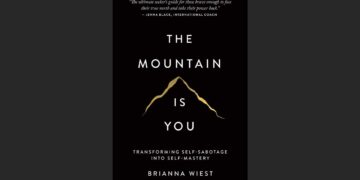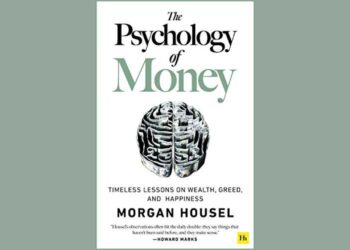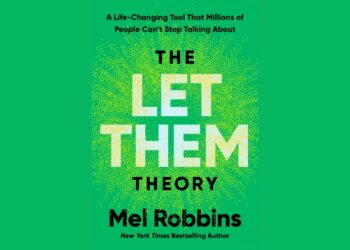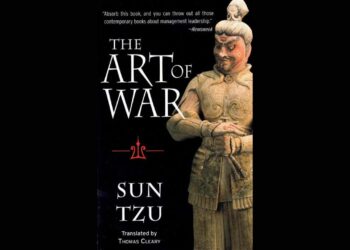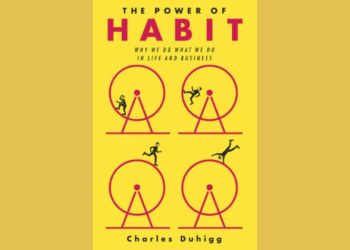Table of Contents
- “The Mountain Is You” Chapter by Chapter
- Chapter 1: The Mountain Is You
- Chapter 2: There’s a Reason You’re Doing This
- Chapter 3: Unlocking Your Own Personal Genius
- Chapter 4: Building Emotional Intelligence
- Chapter 5: Releasing the Past
- Chapter 6: Building a New Future
- Quotes from the Book
- Short Review
- Who Should Read This Book?
- FAQs for “The Mountain Is You”
Book Summary in One Sentence: This book is about confronting the self-sabotage that blocks your potential, understanding that you are not just the climber but also the mountain you must overcome.
“The Mountain Is You” Chapter by Chapter
“The Mountain Is You: Transforming Self-Sabotage Into Self-Mastery” by Brianna Wiest is a profound guide to understanding the deep-seated reasons behind our self-defeating behaviors. It reframes the struggles we face not as external obstacles but as internal ones we create. The central metaphor is powerful: the mountain we must climb is, in fact, ourselves—our fears, our past traumas, our limiting beliefs. To achieve true self-mastery is to summit this internal mountain. The book is a journey, taking the reader from the base of awareness to the peak of a new, consciously created life.
Chapter 1: The Mountain Is You
This foundational chapter introduces the core concept of the entire book: self-sabotage is the mountain. Wiest posits that the biggest, most daunting challenges we face in life are not external circumstances but internal blockades we erect ourselves. These behaviors aren’t born from a desire to fail but from a subconscious need to meet unmet needs, often rooted in past experiences.
Wiest explains that self-sabotage is a form of misguided self-preservation. It’s our psyche’s clumsy attempt to protect us from potential pain, rejection, or failure. For example, procrastinating on a major project isn’t laziness; it might be a way to avoid the potential judgment that comes with completing it. Staying in a comfortable but unfulfilling job isn’t a lack of ambition; it could be a way to avoid the uncertainty and risk of pursuing a dream. These behaviors provide a short-term sense of safety and control, even if they sabotage our long-term happiness and growth.
A key idea introduced here is the conflict between our conscious desires and our subconscious comfort zones. We might consciously want success, love, and fulfillment, but our subconscious mind is wired to keep us in familiar territory, even if that territory is miserable. Self-sabotage is the friction that arises from this internal conflict. The chapter argues that we cannot conquer this mountain by fighting it or trying to force our way up. Instead, we must understand its geology—the underlying reasons for its existence. The first step is radical self-awareness: recognizing that the obstacle is not “out there” but “in here.” It’s about shifting the locus of control from external to internal and accepting the profound responsibility that you are the only one who can truly get in your own way.
Chapter 2: There’s a Reason You’re Doing This
This chapter delves into the “why” behind self-sabotage, moving from abstract concepts to concrete psychological principles. Wiest argues that self-sabotaging behaviors are not random acts of self-destruction but coping mechanisms that have outlived their usefulness. They were likely developed in childhood or in response to past trauma as a way to survive difficult situations. A child who learned to be quiet and invisible to avoid a parent’s anger might grow into an adult who sabotages their career by not speaking up in meetings. The coping mechanism that once ensured safety now ensures stagnation.
Wiest explores the concept of cognitive dissonance, the mental discomfort experienced when holding two or more contradictory beliefs, ideas, or values. To resolve this discomfort, we often resort to self-sabotage. For instance, if you believe you are unworthy of love (a core belief) but someone shows you genuine affection (a contradictory experience), you might sabotage the relationship to align the external reality with your internal belief. It feels easier to prove your negative belief right than to overhaul your entire sense of self.
Another critical point is that we often sabotage things when we are on the precipice of a major breakthrough. This is because success brings new challenges, new responsibilities, and a new identity. This change can be terrifying to the subconscious, which craves stability. Therefore, we pull back right before we achieve the goal, retreating to the safety of the “known.” The chapter urges readers to become detectives of their own lives, tracing their self-defeating patterns back to their origins. Understanding the root cause is not about blaming the past but about liberating the present. It’s about recognizing that the old armor that once protected you is now weighing you down.
Chapter 3: Unlocking Your Own Personal Genius
Here, Wiest pivots from analyzing the problem to beginning the solution. She introduces the idea that within each of us lies a “personal genius,” which is our unique and authentic self, unburdened by fear and limiting beliefs. This genius isn’t about intellectual prowess; it’s about emotional intelligence and deep self-awareness. Unlocking it is the key to overcoming the mountain.
The chapter focuses heavily on developing emotional intelligence. Wiest breaks this down into several key components:
- Self-Awareness: The ability to recognize and understand your own emotions. This is the foundation. You cannot change what you do not acknowledge. Wiest suggests practices like journaling and mindfulness to observe your feelings without judgment.
- Self-Regulation: The ability to manage your emotional responses. Instead of reacting impulsively based on fear or anger, you learn to pause, process the emotion, and choose a constructive response. This is about moving from being a slave to your feelings to being the master of them.
- Motivation: Harnessing your emotions to achieve your goals. This involves understanding your “why” on a deep, emotional level. When your goals are connected to your core values, your motivation becomes intrinsic and resilient.
- Empathy: Understanding the emotions of others. While this seems externally focused, Wiest argues it’s crucial for self-mastery. Understanding others helps you navigate relationships better and see yourself more clearly through your interactions.
Wiest also discusses the importance of identifying your core beliefs. These are the fundamental assumptions you hold about yourself, others, and the world. Many self-sabotaging behaviors stem from negative core beliefs like “I am not good enough” or “I am unlovable.” The chapter provides a framework for challenging these beliefs by seeking evidence to the contrary and consciously replacing them with more empowering ones. This is the hard, internal work of re-scripting the narrative of your life.
Chapter 4: Building Emotional Intelligence
This chapter serves as a practical, hands-on guide to developing the concepts introduced in the previous one. It moves from the “what” of emotional intelligence to the “how.” Wiest emphasizes that emotional intelligence is not a fixed trait but a skill that can be cultivated through consistent practice.
One of the primary techniques she advocates is radical acceptance. This means acknowledging your feelings and thoughts without judging them as “good” or “bad.” If you feel envy, instead of shaming yourself for it, you simply observe it: “I am feeling envy right now.” This creates distance between you and the emotion, allowing you to analyze it. What is this envy telling you? Perhaps it’s highlighting a desire you haven’t acknowledged. By listening to your emotions instead of suppressing them, you turn them from adversaries into guides.
Wiest also explores the concept of the inner child. She explains that many of our strongest emotional reactions are actually the reactions of our wounded inner child. When we feel disproportionately upset by minor criticism, it might be the child within us who feared disapproval from a parent. Healing the inner child involves revisiting these past wounds with the compassion and understanding of your adult self. It’s about re-parenting yourself—giving yourself the validation, safety, and love you may not have received.
The chapter provides practical exercises, such as “trigger tracking,” where you identify situations that provoke strong emotional responses and work backward to understand the root cause. It also stresses the importance of developing a “window of tolerance”—the optimal zone of arousal where you can function most effectively. When you are pushed outside this window (either into hyper-arousal/anxiety or hypo-arousal/shutdown), your ability to think rationally diminishes. Techniques like deep breathing, grounding exercises, and mindfulness help you stay within or return to this window.
Chapter 5: Releasing the Past
This chapter tackles one of the heaviest loads we carry up the mountain: our past. Wiest argues that we cannot build a new future until we have made peace with what has been. This doesn’t mean forgetting or condoning past hurts, but rather releasing the emotional charge they hold over our present.
A key theme is the distinction between pain and suffering. Pain is an unavoidable part of life—we all experience loss, heartbreak, and disappointment. Suffering, however, is the story we attach to the pain. It’s the rumination, the resentment, the “why me?” narrative that keeps us trapped. Releasing the past is about letting go of the suffering, even if the memory of the pain remains.
Wiest introduces powerful frameworks for this process. One is radical forgiveness—not for the benefit of the person who hurt you, but for your own. Holding onto anger and resentment is like drinking poison and expecting the other person to die. Forgiveness cuts the cord, freeing up your emotional energy to focus on the present and future. This includes forgiving yourself for past mistakes and self-sabotaging behaviors. You did the best you could with the awareness you had at the time.
The chapter also emphasizes the importance of re-narrating your story. We are all storytellers, and the narrative we construct about our lives shapes our reality. If your story is “I am a victim of my past,” you will continue to act like one. Wiest encourages readers to reframe their experiences not as sources of permanent damage but as sources of strength, resilience, and wisdom. Your scars are proof that you survived. The goal is to transform your trauma into your purpose. It’s about taking the raw material of your past and building something new and beautiful with it.
Chapter 6: Building a New Future
With the foundation of self-awareness laid and the baggage of the past released, this final chapter focuses on the ascent. It’s about consciously and intentionally designing a life that aligns with your authentic self. This is not about wishful thinking but about practical, actionable steps.
Wiest argues that true change comes from aligning your daily habits with your long-term vision. It’s not the grand, sweeping gestures that transform your life, but the small, consistent actions you take every day. If you want to be a writer, the crucial action is not waiting for inspiration but sitting down to write for 15 minutes each day. These micro-habits build momentum and rewire your brain for success. They create tangible proof that you are becoming the person you want to be.
A significant concept in this chapter is living from your “future self” instead of your “past self.” This involves getting crystal clear on the person you want to become—how they think, feel, and act. Then, in moments of decision, you ask yourself: “What would my future self do?” This shifts your perspective from being driven by past fears and limitations to being pulled by future possibilities. It makes the desired future an active participant in your present.
The chapter also stresses the importance of setting healthy boundaries. Boundaries are not walls to keep others out; they are guidelines to teach people how to treat you and to protect your energy. Learning to say “no” to things that drain you or don’t align with your values is essential for creating space for the things that do.
Finally, Wiest concludes by bringing it all back to the central metaphor. Summiting the mountain isn’t a one-time event; it’s a continuous process of becoming. Self-mastery isn’t a destination you arrive at, but a way of being you inhabit. The goal is not just to get to the top but to learn how to navigate the terrain of your own inner world with grace, compassion, and wisdom. The ultimate freedom is not the absence of a mountain, but the knowledge that you have the strength and skill to climb any peak that rises within you.
Quotes from the Book
- “You are not in the mountain, the mountain is in you.”
- “The greatest act of self-love is to no longer accept a life you are unhappy with.”
- “Your new life is going to cost you your old one. It’s going to cost you your comfort zone and your sense of direction.”
- “True healing is not the absence of the wound, it is the integration of it.”
- “Stop thinking about what you want and start thinking about who you want to be. The former is a destination, the latter is a direction.”
- “What you are afraid of is not the thing itself, but your feeling about the thing.”
- “You must learn to be the hero of your life, not the victim.”
Short Review
“The Mountain Is You” is a remarkably clear, compassionate, and actionable guide to understanding and overcoming the universal human struggle of self-sabotage. Brianna Wiest has a gift for distilling complex psychological concepts into accessible prose, making topics like cognitive dissonance and inner child work feel understandable and manageable. The book’s core metaphor is its greatest strength; reframing personal obstacles as an internal “mountain” is empowering, shifting the reader from a passive victim of circumstance to an active agent of their own life. While some concepts may feel familiar to those well-versed in self-help literature, Wiest’s synthesis and gentle, encouraging tone make the journey feel fresh and deeply personal. It’s less of a quick-fix manual and more of a profound companion for the deep, necessary work of building self-awareness and emotional resilience. It is a powerful read for anyone ready to stop getting in their own way.
Who Should Read This Book?
This book is highly recommended for:
- Chronic Procrastinators and Perfectionists: Individuals who find themselves constantly delaying important tasks or getting stuck in a cycle of analysis paralysis, unable to move forward for fear of not doing it perfectly.
- Anyone Feeling “Stuck”: People who feel a persistent gap between where they are in life and where they want to be, but can’t quite identify what is holding them back.
- Individuals in Repetitive Unhealthy Patterns: Those who repeatedly find themselves in similar toxic relationships, unfulfilling jobs, or debt cycles, and are ready to understand their role in creating these patterns.
- Those on a Journey of Self-Awareness: Anyone interested in psychology, emotional intelligence, and personal development who wants a practical framework for applying these concepts to their own life.
- People Healing from a Difficult Past: Individuals who recognize that past experiences or traumas are still influencing their present-day decisions and behaviors and are seeking a way to release that hold.
FAQs for “The Mountain Is You”
1. Is this book based on scientific principles?
Yes, while written in an accessible, non-academic style, the book’s core ideas are rooted in established psychological principles, including cognitive behavioral therapy (CBT), attachment theory, emotional intelligence, and trauma-informed care.
2. How is this book different from other self-help books?
Its primary distinction is its powerful central metaphor of the “mountain” being oneself. This reframes the problem of self-sabotage not as a character flaw to be fixed, but as a complex internal system to be understood and navigated. It focuses more on the “why” behind our behaviors rather than just offering surface-level “how-to” tips.
3. Will this book solve all my problems?
No book can solve all your problems. “The Mountain Is You” is not a magic bullet. It is a guide and a toolkit. It provides the insights and frameworks for you to do the deep, often difficult, internal work required for lasting change. The transformation it speaks of requires active participation, reflection, and consistent effort from the reader.
4. Is the book practical? Does it offer actionable advice?
Absolutely. While the first part of the book is dedicated to understanding the root causes of self-sabotage, the latter chapters are filled with practical advice. It includes guidance on developing emotional intelligence, reframing negative thoughts, setting boundaries, healing past wounds, and building new, constructive habits.
5. Is the book suitable for someone completely new to self-help concepts?
Yes, it’s an excellent starting point. Brianna Wiest does a fantastic job of explaining complex ideas in a simple, clear, and compassionate way. It’s accessible to beginners while still offering profound insights for those already familiar with personal development literature.
